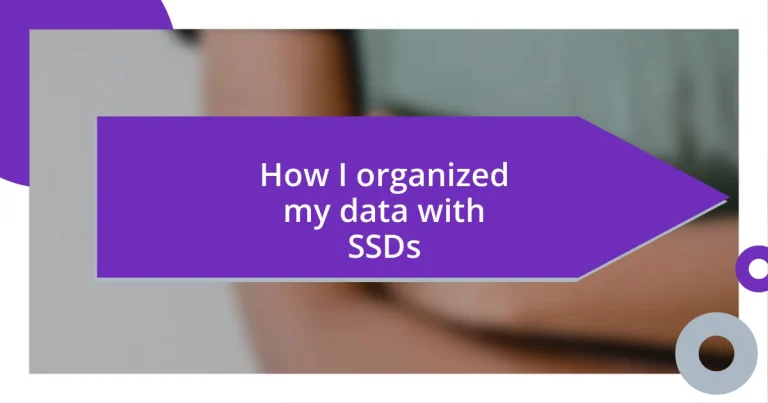Key takeaways:
- SSDs offer significant benefits over traditional hard drives, including faster data access, durability, and enhanced security against data loss.
- Organizing data with a logical folder structure, regular data management, and consistent file naming can greatly improve retrieval efficiency and reduce digital clutter.
- Maintaining SSD health involves avoiding overfilling, keeping firmware updated, enabling TRIM, limiting heavy writing tasks, and monitoring drive health regularly.

Understanding SSDs and Their Benefits
Solid State Drives (SSDs) have revolutionized how we store and access data. Unlike traditional hard disk drives, SSDs use flash memory, which means they have no moving parts. I remember the first time I switched to an SSD; my computer booted up in a fraction of the time it used to. Isn’t it refreshing to feel that instant responsiveness, especially when you’re in the middle of an important project?
One of the standout benefits of SSDs is their durability. Since there are no mechanical components that can wear out, I found that my data felt more secure. There’s something undeniably comforting in knowing that even if I accidentally drop my laptop, my precious files are safe. Have you ever experienced the panic of data loss? With SSDs, that fear diminishes significantly.
Moreover, the speed at which SSDs read and write data is truly impressive. For instance, when I transferred large video files, the process took mere minutes instead of hours. This efficiency not only saves time but also makes work feel seamless and less stressful. In a world where we are constantly rushed, doesn’t it make sense to utilize technology that keeps pace with our lives?

Best Practices for Data Organization
When organizing data on SSDs, I’ve found that consistency is crucial. I like to create a logical folder structure, with main categories driving the divisions. For example, I use broad labels like “Work,” “Personal,” and “Projects” and then break those down further into subfolders. This approach not only makes retrieval faster but also adds a sense of calm to my digital environment—have you seen how chaotic one might feel with rivers of files everywhere?
Another effective practice I’ve adopted is regular data management. I schedule time every month to review my data, deleting what I no longer need and backing up essential files. I remember the last time I updated my data—it was astonishing to see how much clutter I had accumulated. It felt liberating to clear that out, reducing anxiety and allowing me to focus on what truly matters.
I also believe in labeling files clearly and consistently. Using descriptive names, along with dates, makes searching for files so much easier. One time, I spent a good hour looking for a critical document because it was saved under a vague title. Now, I make it a habit to name files in a way that tells me exactly what they are, right from the get-go. What about you? How do you name your files?
| Best Practices | Benefits |
|---|---|
| Create Logical Folder Structure | Improved retrieval time |
| Regular Data Management | Reduction of digital clutter |
| Consistent File Naming | Easier searchability |

Maintaining Your SSDs for Longevity
Maintaining the health of your SSD is essential for ensuring its longevity. I’ve learned that simply avoiding excessive writing and erasing cycles can significantly extend its lifespan. For instance, I once faced a scare when my SSD started to slow down, and I realized it was because I had filled it to capacity. It was a wake-up call that made me more mindful about not only how much data I saved but also how often I accessed heavy files.
Here are some of the best practices I recommend for SSD maintenance:
- Avoid Overfilling: Keep your SSD less than 75% full. This keeps performance steady and lets the drive manage space efficiently.
- Regular Firmware Updates: Keeping the SSD firmware updated can enhance performance and stability.
- Enable TRIM: This command helps the SSD manage unused data blocks, maintaining speed and preventing slow-downs over time.
- Limit Heavy Writing Tasks: Reduce frequent large file transfers to avoid unnecessary wear on the SSD, especially with larger storage capacities I’ve encountered.
- Monitor Drive Health: Regularly check the SSD’s health using software tools. It’s comforting to have a handle on how your drive is performing.

Troubleshooting Common SSD Issues
When troubleshooting SSD issues, the first step is to check for connection problems. I remember one day when my laptop wouldn’t recognize my SSD, and after some frustrating moments, it turned out that the cable had loosened. Have you ever faced similar issues? Sometimes, just reseating the drive or cables can resolve these seemingly catastrophic problems in no time.
Another common issue is slow performance. I once had a situation where my SSD began lagging, and it was disheartening to watch my work slow down. After a bit of research, I discovered it was due to the drive being nearly full. Implementing a clean-up strategy not only boosted its speed but also alleviated that nagging worry every time I used it. I highly recommend regularly checking storage levels and cleaning out unnecessary files—trust me, it makes a huge difference.
If you encounter random crashes or data corruption, it’s worth looking into the firmware. I experienced this with one of my earlier SSDs, and updating its firmware resolved those intermittent crashes. It was a real relief to finally have a reliable drive again. Have you considered how critical these updates are? Just like with software on our devices, they can vastly improve performance and stability.














